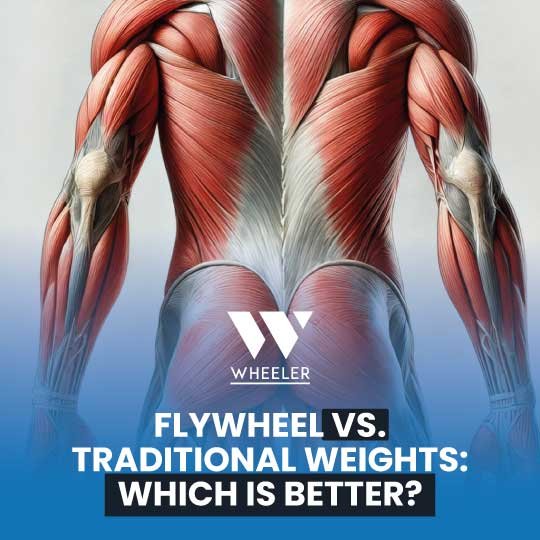Hello Coaches,
When it comes to strength training, the debate between flywheel devices and traditional weights has been gaining traction in recent years. While both methods are effective for building strength and performance, flywheel training offers unique benefits that traditional weights cannot replicate. In this article, we’ll compare the two approaches, explore their advantages and limitations, and help you determine how to use each method in your athletes’ training programs.
How Flywheel Training and Traditional Weights Work
Flywheel Training
Flywheel devices use inertial resistance generated by a rotating disc. The athlete creates force during the concentric phase, which then produces an equal and opposite resistance during the eccentric phase. This provides a constant resistance that adjusts dynamically to the athlete’s output.
Traditional Weights
Weights rely on gravity to provide resistance. The load remains constant throughout the movement, regardless of the effort the athlete exerts. Exercises can target concentric, eccentric, or isometric phases, but the resistance is fixed.
Advantages and Limitations
Advantages of Flywheel Training
- Eccentric Overload: Flywheel training excels at maximizing the eccentric phase, a critical component for strength and injury prevention. Athletes can generate higher levels of force during the eccentric portion, leading to superior muscle adaptations.
- Adaptive Resistance: The resistance in flywheel training is directly proportional to the athlete’s effort. This means:
- There’s no limit to the amount of force that can be produced.
- The device adjusts dynamically, ensuring optimal stimulation at all effort levels.
- Improved Muscle Architecture: Flywheel training is more effective at increasing fascicle length, particularly in the hamstrings, compared to traditional weights. Longer fascicles are associated with improved performance and reduced injury risk.
- Functional Movements: Flywheel exercises often mimic sports-specific movements, making them more applicable to athletic performance. Movements like lateral lunges or hip thrusts are directly transferable to sports actions.
- Lower Risk of Injury: Because flywheel resistance adjusts to the athlete’s effort, there’s less risk of overloading during a single repetition. This makes it a safer option for rehabilitation and high-intensity training.
Advantages of Traditional Weights
- Simplicity and Accessibility: Weights are widely available and require minimal technical setup, making them more accessible for most training environments.
- Progressive Overload: Adding weight plates allows for precise, linear progression. This simplicity makes weights an excellent tool for building foundational strength.
- Versatility: Weights can be used for a wide variety of exercises targeting every muscle group. Compound lifts like squats, deadlifts, and bench presses are staples of strength programs.
- Hypertrophy Training: Traditional weights are particularly effective for hypertrophy, as constant resistance throughout the range of motion is ideal for muscle growth.
Limitations of Flywheel Training
- Cost and Equipment Availability: Flywheel devices are expensive and may not be accessible in all training facilities. This limits their use, particularly in team settings with large groups of athletes.
- Learning Curve: Proper flywheel technique requires supervision, especially for athletes new to this type of resistance. Without guidance, athletes may struggle to fully utilize the device’s potential.
- Not Ideal for Maximum Strength Testing: While flywheel training excels in dynamic and eccentric movements, it is less suited for testing or building pure maximal strength compared to traditional weights.
Limitations of Traditional Weights
- Fixed Resistance: Weights provide constant resistance that doesn’t adapt to the athlete’s effort. This limits eccentric overload, as most athletes focus on the concentric phase during lifts.
- Limited Eccentric Emphasis: Achieving eccentric overload with weights often requires additional techniques, such as spotters or specialized equipment, which can be impractical in some settings.
- Higher Injury Risk: Lifting heavy weights without proper technique can lead to injuries, particularly during high-intensity sets or maximal lifts.
Which Should You Use?
Choose Flywheel Training if:
- You want to emphasize eccentric strength and injury prevention.
- Your athletes need sport-specific movements that mimic game actions.
- You’re working on fascicle lengthening or rehabilitation programs.
Choose Traditional Weights if:
- Your goal is to build maximal strength or muscle mass.
- You’re working with large groups and need simple, scalable solutions.
- You want to incorporate foundational lifts like squats and deadlifts.
Combine Both if:
- You’re creating a comprehensive program that addresses all aspects of athletic development. For example, use traditional weights for strength phases and flywheel training for eccentric overload and sports-specific preparation.
Conclusion
Flywheel training and traditional weights each offer unique advantages, and the best approach often involves combining the two. Flywheel training, particularly with flywheel workout machines, is a powerful tool for eccentric strength, injury prevention, and functional performance. Meanwhile, traditional weights remain indispensable for building foundational strength and muscle hypertrophy. By understanding the strengths and limitations of each, you can create a balanced, effective program tailored to your athletes’ needs.
What’s your experience with flywheel training and traditional weights? Share your thoughts and let’s keep improving together!
Author


